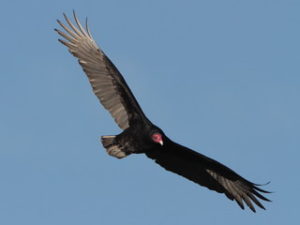(Cathartes aura)

There are two species of vultures in Georgia, the turkey vulture and the black vulture. Turkey Vultures usually weigh about 5 lbs. with a 6 foot wingspan. They appear black from a distance but are actually a brownish-black with feathers on the wings appear to be silvery-gray beneath. The adult’s head is small in proportion to its body and is red in color with few to no feathers but usually have black heads when they are younger causing some people to mistake them for Black Vultures. It also has a relatively short, hooked, ivory-colored beak They soar with their wings in a pronounced V – shape with a light gray trailing edge on the underside of their wings and with a longer tail than Black Vultures. They are clumsy on the ground and it takes them great effort to take off in flight.
Turkey vultures breed throughout Georgia, usually starting in January and continuing through March. They do not build nests but instead lay their eggs in hollow logs, trees, brush piles or even deserted buildings. Turkey vultures will lay two white eggs, sometimes spotted and splotched with brown. Pairs typically mate for life.
 Turkey vultures hunt for food by smell, often flying low to the ground to pick up the scent of dead animals. They have the largest olfactory (smell) system of all birds and are capable of smelling carrion from over a mile away. They eat mostly carrion and therefore have adaptations for this. Vultures prefer meat as fresh as possible and won’t eat extremely rotted carcasses. Their bare heads are adapted for feeding on animal carcasses. Their extremely corrosive digestive acids can kill bacteria and viruses. Their nostrils are not divided and so that they can clear debris from their nostril with a talon. They urinate on their legs to help cool their feet in hot weather and to kill bacteria that they get on their feet from walking on carrion.
Turkey vultures hunt for food by smell, often flying low to the ground to pick up the scent of dead animals. They have the largest olfactory (smell) system of all birds and are capable of smelling carrion from over a mile away. They eat mostly carrion and therefore have adaptations for this. Vultures prefer meat as fresh as possible and won’t eat extremely rotted carcasses. Their bare heads are adapted for feeding on animal carcasses. Their extremely corrosive digestive acids can kill bacteria and viruses. Their nostrils are not divided and so that they can clear debris from their nostril with a talon. They urinate on their legs to help cool their feet in hot weather and to kill bacteria that they get on their feet from walking on carrion.
Vultures are very gregarious birds, feeding together and assembling in large flocks to roost at night. They provide us a great scavenging service. However, they can also be quite destructive when roosting as they regurgitate and defecate a lot which is foul and smelly, and also becomes a health hazard. This can also kill plant matter.
Black vultures are slightly smaller than Turkey Vultures and usually weigh 4.5 lbs., with a 4.5 – 5 foot wingspan. They are black in color including the the bare skin on their heads. They are also more aggressive and dominate Turkey Vultures at feeding sites. They find their prey by sight and often follow Turkey Vultures to carrion.
Click on image to the left for more info.
Fun Facts:
Turkey vultures are the only scavenger birds that can’t kill their prey. They were known as the “Peace Eagles” by the Cherokee people because they are unable to kill.
Groups of perched vultures are called a wake.
If a turkey vulture is disturbed or harassed, it will throw up in the direction of whatever is bothering it.
Groups of vultures spiraling upward to gain altitude are called “kettles”.
Neither species has a voice box and can only make sounds like grunts and
hisses.
The Turkey Vulture, with its bald red head and dark feathers, was given its common name due to its superficial resemblance to the Wild Turkey.
Turkey vultures can swoop up to 60 mph in order to avoid being “mobbed” by ravens or jays.
Some times they are referred to as “Buzzards” however this is a term used by Europeans for certain types of hawks.
The word, vulture, comes from a Latin word that means “to pluck or tear,” referring to a vulture’s feeding techniques.
The Turkey Vulture’s scientific name is Cathartes aura which is Latin for “cleansing breeze.”

